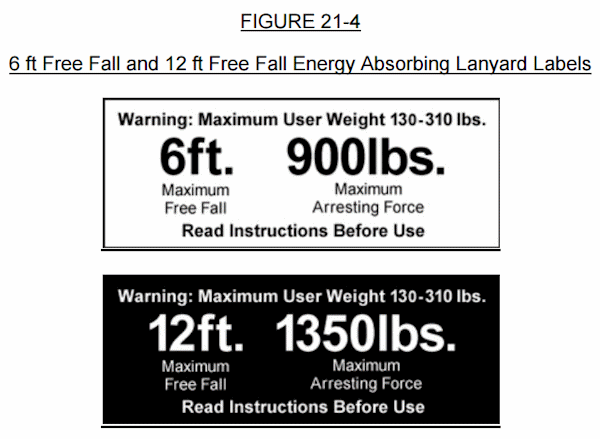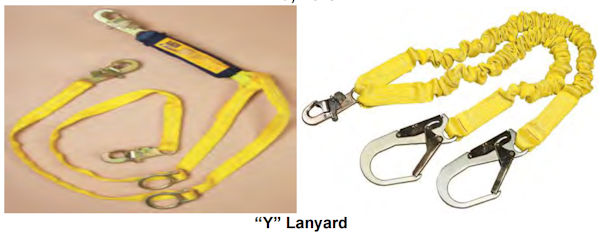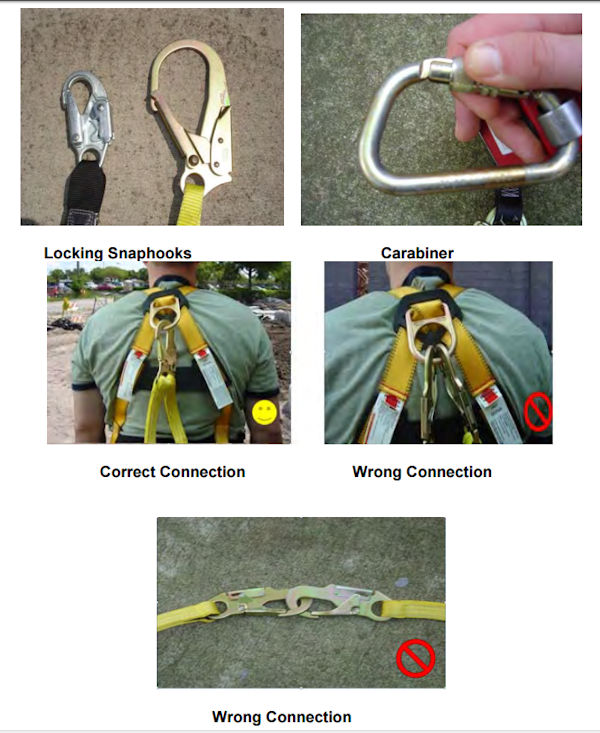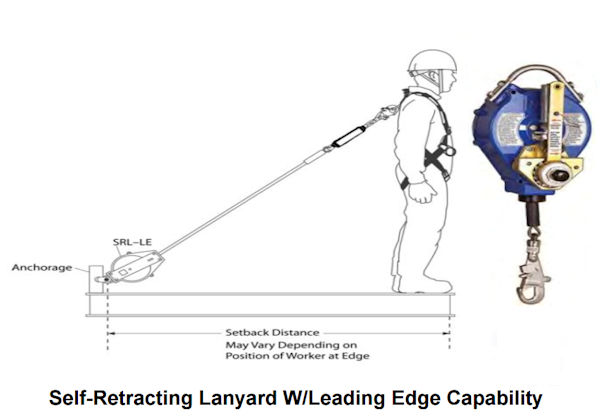21.I.07 PFAS - Connecting Means.
Connecting subsystems may include energy absorbing lanyards (shock absorbing lanyards) with snap hooks or carabiners at each end, self-retracting devices (SRDs), and/or fall arrestors (rope grabs).
- Lanyards - General. Lanyards must be made of ropes, straps or webbing made from synthetic materials. Energy absorbing lanyards, (including rip stitch/tearing and deforming lanyards) must be capable of sustaining a minimum tensile load of 5,000 lbs (22.2 kN). The maximum length of single or "Y" lanyards used in fall arrest must not exceed 6 ft (1.8 m).
- (1) The 6 ft (1.8 m) Free Fall (FF) energy absorbing lanyard must only be used when the tie-off point is above the dorsal D-ring creating a FF distance of less than 6 ft. The energy absorber must have an average arrest force of 900 lbs (4 kN) and a maximum deployment distance of 4 ft (1.2 m). > See ANSI Z359.13, Par 3.1.8.1.
- (2) When an anchor point is below the dorsal D-ring, a FF distance greater than 6 ft (1.8 m) is created. For these situations, a 12 ft (3.6 m) FF energy absorbing lanyard must be used in accordance with manufacturer's instructions and recommendations. The energy absorber must have an average arrest force of 1,350 lbs (6 kN) and the maximum deployment distance of 5 ft (1.5 m). > See ANSI Z359.13, Par 3.1.8.2.
Note: A 12 ft (3.6 m) FF energy absorbing lanyard does not refer to the lanyard length. Instead it refers to a FF that is greater than 6 ft (1.8 m) up to 12 ft which is created by the anchor point being located below the dorsal D-ring. The maximum length of the lanyard used must not exceed 6 ft. > See Figure 21-4.
- (3) The 6 ft (1.8 m) and 12 ft (3.6 m) FF energy absorbing lanyards must meet the requirements of ANSI Z359.13 Standard.
- Note: Lanyards must not be looped back over or through an object and then attached back to themselves unless permitted by the manufacturer.
- "Y" Lanyards. When using lanyard with two integrally connected legs for 100% tie-off, attach only the snap hook at the center of the lanyard must be attached to the fall arrest attachment element of the harness (D-ring).
- (1) The two legs of the lanyard and the joint between the legs must withstand a force of 5,000 lbs (22.2 kN).
- (2) When one leg of the lanyard is attached to the anchorage, the unused leg of the lanyard must not be attached to any part of the harness except to attachment points specifically designated by the manufacturer for this purpose.
- (3) The 6 ft (1.8 M) FF "Y" lanyard must only be used when the tie-off point is above the dorsal D-ring height and when the FF distance is less than 6 ft.
- (4) When the tie-off point is located below the dorsal D-ring, the FF distance is greater than 6 ft (1.8 m) so a 12 ft (3.6 m) FF "Y" lanyard may be used.
- Note: A 12 ft (3.6 m) FF energy absorbing "Y" lanyard does not refer to the lanyard length. Instead it refers to a FF that is greater than 6 ft (1.8 m) up to 12 ft which is created by the anchor point being located below the dorsal D-ring. The maximum length used must not exceed 6 ft.
- (5) The maximum arrest force on the body must not exceed 1800 lbs (8 kN).
- (6) The 6 ft (1.8 m) and 12 ft (3.6 m) FF energy absorbing "Y" lanyards must meet ANSI/ASSP Z359.13 standard.
- Note: Effective 2 years from date of publication, all energy absorbers used must be equipped with a deployment indicator.
- Hardware (connecting components).
- (1) Snap hooks and carabiners must be self-closing and self-locking, capable of being opened only by at least two consecutive deliberate actions. Snap hooks and carabiners having minimum gate strength of 3,600 lbs (16 kN) in all directions, per ANSI Z359.12 must be used.
- (2) Snap hooks and carabiners must have a minimum tensile strength of 5,000 lbs (22.2 kN); D-rings, O-rings, snap hooks and carabiners must be capable of withstanding a tensile load of 5,000 lbs.
- (3) Connectors, adjusters, and any buckles used as adjusters must be capable of withstanding a minimum tensile load of 3,372 lbs (15 kN) and must be made of drop forged, pressed or formed steel, or made of equivalent materials; must have corrosion resistant finish; and all surfaces and edges must be smooth to prevent damage to interfacing parts of the system.
- (4) All connecting components used in PFAS must be compatible and must be used properly.
- Self Retracting Devices (SRDs). The SRDs must meet the requirements of the ANSI/ASSP Z359.14 standard.
- (1) A Self-retracting lanyard (SRL) is a device mounted or anchored such that the arrest distance must not exceed 2 ft (60 cm), and the average arrest force must not exceed 1,350 lbs (6 kN) or a maximum peak force of 1,800 lbs (8 kN). The SRL is only used for vertical applications.
- (2) An SRL with leading edge capability (SRL-LE) is designed for applications where during use, the device is not necessarily mounted or anchored overhead and may be at foot level and where the possible free fall distance from the edge is up to 5 ft (1.5 m) and the average arrest distance must not exceed 4.5 ft (1.37 m). The device is equipped with an energy absorber to withstand impact loading of the line with a sharp or abrasive edge during fall arrest and for controlling fall arrest forces on the worker.
- Note: Effective 2 years from date of publication, all SRDs used must be equipped with visual indicator.
- Fall arrestors (rope grabs) designed to be used with a vertical lifeline and ladder climbing devices (rope, cable or rail) must be approved by the manufacturer for such use. Fall arresters must have a minimum ultimate strength of 3,600 lbs (16 kN).
- Note: For vertical lifelines or ladder climbing devices, use the automatic fall arrestors that move in one direction only.
Knowledge Check Choose the best answer for the question.
21-9. Which PFAS component may be used only for vertical applications?
You forgot to answer the question!




